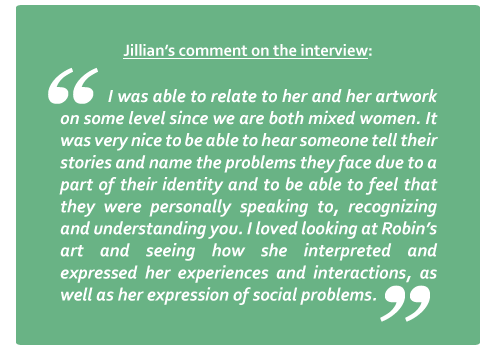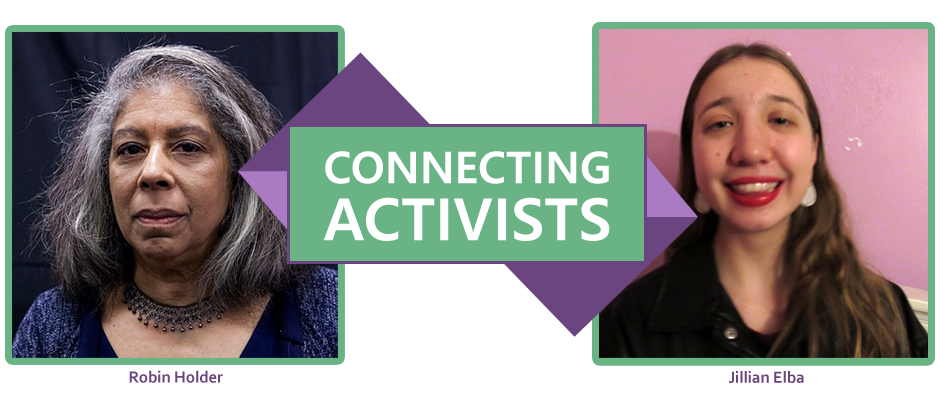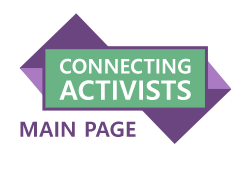Jillian Elba, Fordham University sophomore, interviewed artist activist Robin Holder in fall 2020
 Recently, I had the opportunity to talk with Robin Holder, a multi-ethnic and bi-racial female artist based in Northern New Jersey. Her art explores a variety of topics such as: the complexities of the human identity (something that she can relate to and has to live with most days as a mixed woman in America) and the larger social issues that work to exclude and oppress those already vulnerable. Her art works as a form of activism, as it forces the audience to consider deeper and institutionalized issues of class, race, gender, ethnicity, immigration status, etc. and to consider their own role in either perpetuating or preventing it. Robin confronts the audience and forces them to ask themselves these questions by portraying her own personal experiences or events that affect her or people in her community. Despite the fact that this may make audiences uncomfortable, Robin only wishes for people to be “comfortable and open” towards her and her art, which she demonstrated to me when she asked me if there was anything I disliked or “found disturbing'' about her art.
Recently, I had the opportunity to talk with Robin Holder, a multi-ethnic and bi-racial female artist based in Northern New Jersey. Her art explores a variety of topics such as: the complexities of the human identity (something that she can relate to and has to live with most days as a mixed woman in America) and the larger social issues that work to exclude and oppress those already vulnerable. Her art works as a form of activism, as it forces the audience to consider deeper and institutionalized issues of class, race, gender, ethnicity, immigration status, etc. and to consider their own role in either perpetuating or preventing it. Robin confronts the audience and forces them to ask themselves these questions by portraying her own personal experiences or events that affect her or people in her community. Despite the fact that this may make audiences uncomfortable, Robin only wishes for people to be “comfortable and open” towards her and her art, which she demonstrated to me when she asked me if there was anything I disliked or “found disturbing'' about her art.
The series of hers that we discussed most in depth was “What’s Black and White and Red All Over? An African American Russian Jewish Red Diaper Baby”. She described her desire to create this series due to the fact that she wanted to track her development as a young girl and how she became aware of her identity. She specifically wanted to consider “the incidents and interactions that indicated what my gender, racial, political and class identity was”. To achieve this, Robin even re-read books that she loved in the past to return to her past thoughts and considerations.
This autobiographical desire is also rooted in her identity as a multi-ethnic, bi-racial woman who was raised in an intellectual family, as she claims another reason she was so drawn to creating this series was, “to discover for myself how is it that I become aware of who I am and how do I utilize the different aspects of my identity and how do I break out of the confines of aspects''. In regards as to who she wanted the audience for this series to be, she said “everybody and anybody”, for she “wanted to spark conversation about these specific events that happened or how these affected people or what they were doing or thinking or feeling during these things that happened and also for younger people to think about and consider and reflect upon how we develop as young people''.
Robin places an emphasis on one’s childhood, for she views this period (specifically from ages 6-16) as the period when one becomes aware of who they are in the world. This development of discovery was something extremely apparent in Robin’s life as she claims that “I was always the only one”. Whether this is in regards to her being “Jewish or dark-skinned or young or a girl”, almost every part of her identity was something that differentiated her from everyone else. Because of this, Robin says that she “didn’t do anything that was expected of me the way that it was expected”.
A particular moment where this was illustrated appears in her piece “half and half” which appears in her series discussed above. This art piece displays three panels, with a younger Robin shown in the middle and two silhouettes of little girls on the outer panels. In the silhouettes of these little girls lies large metal chains which take over the entirety of their bodies. Under the younger Robin in the middle are words which describe the event portrayed in the art. To see this piece and Robin’s other work, just click here.
With “half and half”, Robin discusses an interaction she had with her friend Elsbeth. During a normal day, Robin was spending time with her friend Elsbeth who lived in her neighborhood. As normal kids, they were simply talking when Elsbeth told Robin that her family ate snake meat and then asked Robin if she wanted to see it. Robin, as any child would, agreed. Robin described the walk over as not specifically abnormal until, “just before we started to go up the stoop, she remembered like in a quick instant, she said ‘oh, my dad doesn’t allow n****rs in the house’ ”. Elsbeth further expressed her confusion in whether or not Robin could come into her house and told Robin, “but you’re half-and-half, so I’m not sure”. Robin responded to this by claiming that half-and-half was something that her mother put in her coffee, not a description of who Robin was.
Robin describes this incident as displaying “two girls who are friends and who want to do what they want to do”, yet are still confined by “remembering the rules and guidelines that their parents gave them” to justify their desires and thoughts. Through this piece, Robin wanted to address our “internal dialogue”. The internal dialogue of the two girls is portrayed by the chains in the silhouettes of the girls (as described above). Robin explained internal dialogue as “a private, personal conversation that’s constantly going on in your head where you are evaluating, interpreting and reflecting on what’s happening”. This occurs when we engage with other people or in activities and Robin wants to emphasize its importance, for she believes that “that life of that internal dialogue is really what informs people and what motivates them to move forward in society”.
This incident and art work also describe the presence of ignorant or naive people in our lives. After going to Elsbeth’s house, all Robin could think about were slaves and Elsbeth’s father and his understanding of black people. The internal dialogue mentioned above actively works when being around ignorant people, as Robin explained that she has “a constant negotiation or navigation with them”, where she is unsure of what to reveal about herself or whether she should comment on something the person said.
Despite the difficulty and discomfort that can occur when being around people we may deem ignorant, Robin believes that one of the most important lessons she ever learnt was when she was in fourth grade and her fourth grade self realized that “most adults were stupid or ignorant or not able to answer my questions, but that I could like them anyways”. This “revelation” came to her when she went to give her favorite teacher her favorite flower (dandelions) and her teacher “drew back” and told her “oh Robin, those are weeds”. Robin described herself as being extremely upset by this incident and believing that her teacher thought her “dandelions were untouchables” (in reference to the Indian caste system).
Robin, however, found that this teacher was still her favorite teacher and that she could still in fact like her. Robin describes this incident and lesson as still impacting her as she told me, “to this day there’s people that I like that I think are really ignorant or inept or unskilled, but it doesn't prevent me from enjoying or appreciating them”. She believes that this lesson is “valuable” and that if more people learnt this, then we would all be more empathetic and compassionate.
While Robin’s life has often been made more difficult due to her identity, she continues to create change and inspire others to do the same whilst passing on her knowledge and stories to whoever is fortunate enough to meet her or witness her art.


